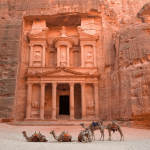Coptic monasteries in Egypt stand as ancient bastions of Christian heritage, embodying centuries of spiritual wisdom, architectural splendor, and cultural richness. Nestled amidst Egypt’s diverse landscape, these monastic communities offer a glimpse into a world where time seems to stand still, preserving traditions that date back to the early days of Christianity. From the remote deserts of Wadi El Natrun to the lush oases of the Nile Valley, Coptic monasteries play a vital role in safeguarding the essence of Coptic Christianity and nurturing a profound connection to Egypt’s storied past. Explore the significance of Coptic monasteries in preserving Christian heritage and delve into the unique legacy they continue to uphold in the modern world.
1. Introduction to Coptic monasteries in Egypt
Overview of Coptic Christianity
Coptic Christianity traces its origins back to the early days of Christianity, with a rich history and distinct traditions that have been passed down through generations.
Significance of Coptic monasteries in Egyptian history
Coptic monasteries hold a special place in Egyptian history, serving as centers of spiritual life, education, and refuge throughout centuries of change and upheaval.
2. Historical background and significance of Coptic monasteries
Origins of Coptic monasticism
Coptic monasticism began in the deserts of Egypt in the 3rd century, with Saint Anthony considered the father of this ascetic tradition that emphasizes prayer, solitude, and community life.
Key historical events shaping Coptic monasteries
Throughout history, Coptic monasteries have faced periods of persecution, yet they have remained steadfast in their commitment to preserving the Christian faith and serving as spiritual sanctuaries for believers.
3. Role of Coptic monasteries in preserving Christian heritage
Preservation of ancient manuscripts and artifacts
Coptic monasteries have played a crucial role in safeguarding ancient manuscripts, relics, and artifacts that offer valuable insights into early Christian history and traditions.
Maintaining ancient rituals and practices
By upholding ancient rituals, liturgies, and spiritual practices, Coptic monasteries ensure that the teachings and customs of early Christians are preserved and passed on to future generations.
4. Architectural and artistic treasures of Coptic monasteries
Distinctive architectural features of Coptic monasteries
Coptic monasteries exhibit unique architectural styles that blend traditional Egyptian influences with Christian symbolism, creating serene and contemplative spaces for worship and reflection.
Iconography and artwork in Coptic monastery settings
The walls and interiors of Coptic monasteries are adorned with intricate iconography and artwork that depict biblical scenes, saints, and symbolic motifs, serving as visual expressions of faith and devotion.
5. Spiritual practices and traditions within Coptic monasteries
Monastic daily routines and prayer practices
Coptic monasteries are known for their daily routines centered around prayer and contemplation. Monks and nuns typically follow a structured schedule that includes morning prayers, work periods, communal meals, and evening worship services. The prayers offered within these sacred spaces are considered to be a vital part of spiritual life and are often conducted in Coptic, the ancient language of Egypt’s early Christians.
Spiritual guidance and mentorship in Coptic monastic communities
Within Coptic monasteries, spiritual guidance and mentorship play a crucial role in the development of monks and nuns. Experienced elders offer wisdom, advice, and support to younger members of the community, helping them navigate the challenges of monastic life and deepen their spiritual practice. This tradition of mentorship fosters a sense of community, continuity, and spiritual growth within Coptic monastic circles.
6. Challenges facing Coptic monasteries in modern times
Environmental threats to Coptic monastery sites
Despite their historical significance, Coptic monasteries face environmental threats such as desertification, water scarcity, and pollution. Climate change and urbanization also pose challenges to the preservation of these ancient sites, highlighting the need for sustainable conservation efforts to safeguard Egypt’s Christian heritage for future generations.
Social and political challenges impacting Coptic monastic life
Coptic monasteries often grapple with social and political challenges that impact their ability to thrive. Issues such as religious discrimination, land disputes, and governmental regulations can limit their autonomy and hinder their mission to preserve Christian traditions. Overcoming these obstacles requires resilience, advocacy, and community support to protect the rich legacy of Coptic monasticism.
7. Impact of Coptic monasteries on local communities
Economic contributions and community outreach programs
Coptic monasteries play a vital role in supporting local economies through agricultural activities, craftsmanship, and tourism initiatives. Additionally, many monasteries engage in community outreach programs that provide food, shelter, and educational opportunities to those in need, fostering a spirit of compassion and solidarity within the surrounding areas.
Educational and healthcare initiatives supported by Coptic monasteries
In addition to their spiritual pursuits, Coptic monasteries are often involved in educational and healthcare initiatives that benefit both their residents and the broader community. Monastic schools, hospitals, and orphanages offer essential services and create opportunities for learning and healing, reflecting the compassionate values of the Christian faith in action.
8. Conclusion: The enduring legacy of Coptic monasteries in Egypt
Coptic monasteries stand as beacons of faith, tradition, and community in Egypt, preserving the rich heritage of Christianity amidst the challenges of modern times. Through their spiritual practices, mentorship traditions, and contributions to local life, these sacred spaces continue to inspire generations with their enduring legacy of devotion, service, and love.In conclusion, the enduring legacy of Coptic monasteries in Egypt serves as a testament to the resilience of faith, the beauty of tradition, and the power of community. As these sacred sites continue to weather the winds of change and preserve the essence of Coptic Christian heritage, their influence reaches far beyond their walls, shaping the cultural landscape of Egypt and inspiring generations to come. Let us cherish and honor the invaluable contributions of Coptic monasteries in safeguarding Christian heritage, for they stand as beacons of light illuminating the path to a richer, more interconnected world.






